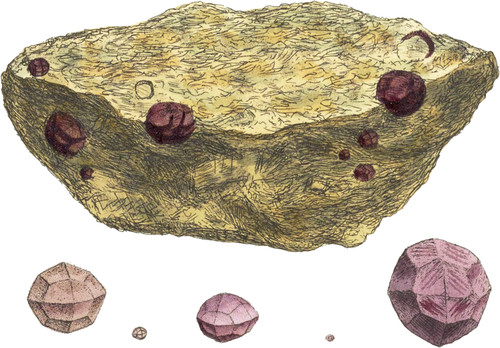 Enlarge
Enlarge
British Mineralogy
Garnet
- Div. 1. Crystallized.
- Var. Trapezoidal.
Garnets in trapezoidal crystals are not so common as in rhomboidal dodecaëdrons and its modifications, for which see tabs. 43, 44, 120 and 364. They, however, occur in some variety, as to the perfection with which they crystallize; their brilliancy, and additional number of facets. Like the former, they are sometimes detached from the rock, or easily separated. The best seem to be most usually in the least decomposed Granites. The upper figure is an irregular fragment of micaceous Granite, of which the reddish part is Feldspar; the whiter part, Quartz; and the whitest, Mica. The Garnets are of a good colour, and have a tolerably natural polish: some are rather compressed, and some have a face or four-sided truncation upon the apex of the four-sided pyramid. The lower middle figure is representative of those in the gangue above, The left hand lower figure is a larger and nearly regular one, of a dull roughish aspect, found detached, or rather having fallen out of a somewhat sandy rock. The other, which is larger, showing the truncation, was sent me detached, with some other favours from Scotland, by the Rev. James Dalton, and the former ones are from the neighbourhood of Aberdeen.
Garnets vary much in size. I have one, with which I was favoured by Lady Wilson, from Scotland, above an inch in diameter, and they are sometimes larger; perhaps they may be found equal to those from Fahlon in Sweden, which I have seen very large; and I have one, a rhomboidal dodecaëdron, nearly five inches in diameter.
These specimens, with their gangues, will be doubly useful when, we come to treat of the Rocks.

